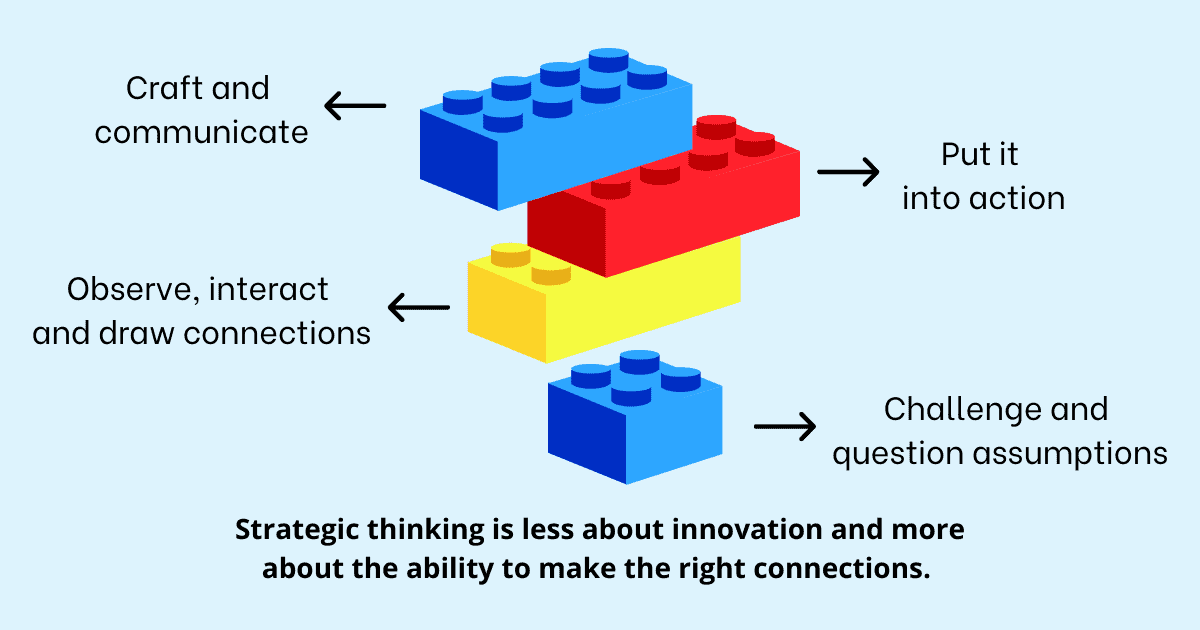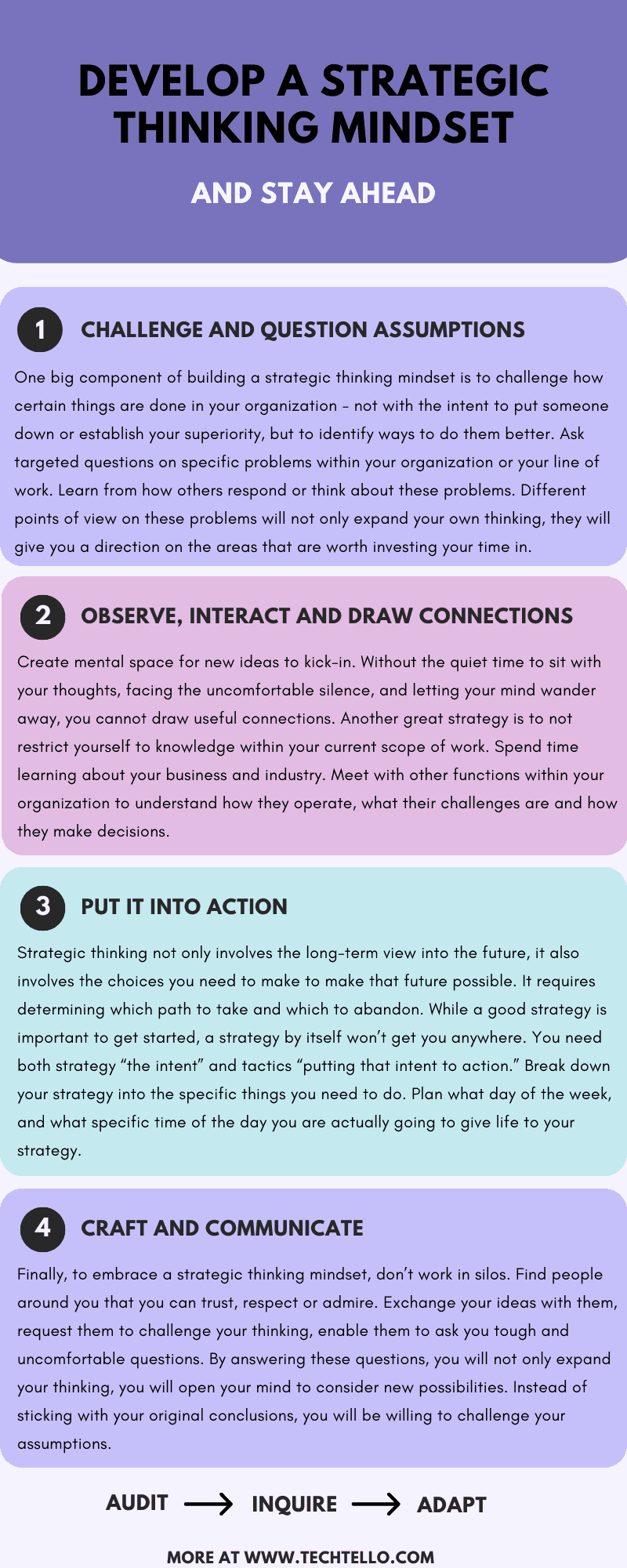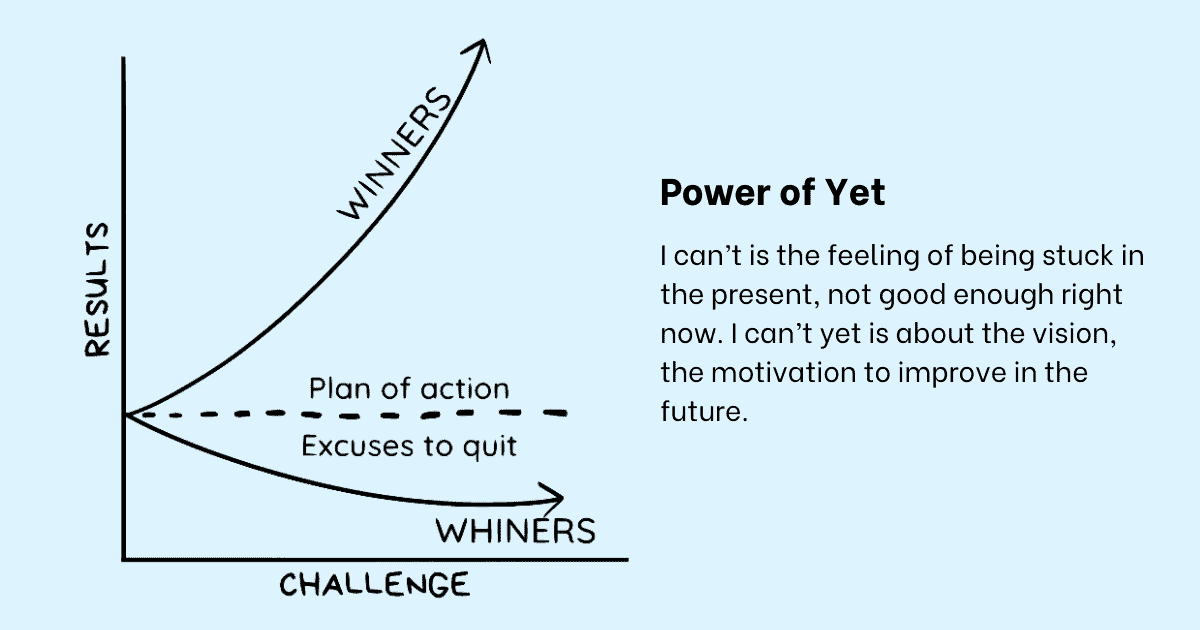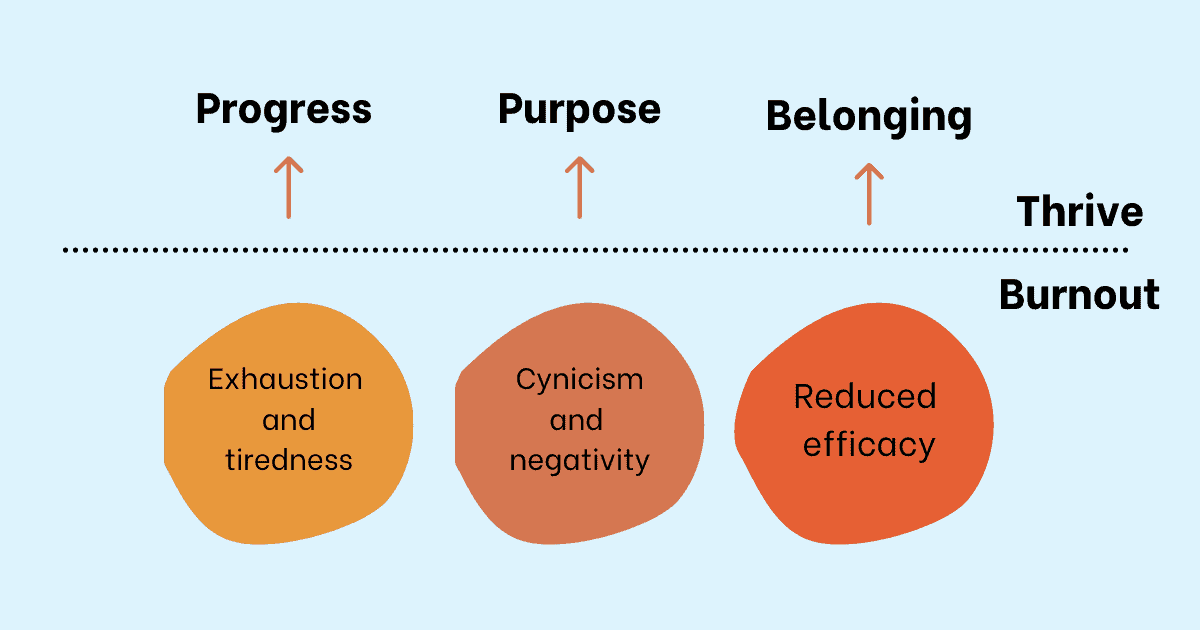Embrace the Strategic Thinking Mindset: How to Develop Your Strategic Thinking Skills and Stay Ahead

Strategic thinking is such a critical skill in life, and yet a lot of us hear about it for the first time in our lives through our managers “You are great at execution, but you need to start thinking strategically.”
Now a corporate mumbo jumbo, strategic thinking wasn’t a popular concept in the early years of my career. I kind of assumed that strategic thinking was reserved for corporates and people higher up in the company who needed to make crucial decisions around the future of an organization. It never occurred to me that thinking strategically isn’t a skill you acquire when you reach a certain position, it’s a skill you build to get to a certain position.
I also believed that when I was ready to climb the corporate ladder, my manager would give me the training to help me build my strategic thinking skills and the opportunities to practice those skills. Call me naive, but that was the corporate world I lived in back then. Much has changed since, but one thing has remained constant. Strategic thinking is as important now (and may be even more) as it was many years ago.
While universally, everyone is expected to have strategic thinking skills at some point in their career, no one is taught to think strategically at work, in college or at school. Much of our education system is structured around a curriculum and how to fit our minds within a box. At school, we are praised for sticking to conventional wisdom and not asking too many questions. The trend continues in college. In the early years of our career, we are rewarded so much for our speed of execution that we fail to realize that our journey ahead is less about doing things and more about deciding the right thing to do.
When a large part of our life is spent executing someone else’s idea, it isn’t easy to break out of that mould and rewire our brain to think above and beyond. But strategic thinking is not a skill you can develop without practice. As Shane Parrish puts it in The Great Mental Models, “Contrary to what we’re led to believe, thinking better isn’t about being a genius. It is about the processes we use to uncover reality and the choices we make once we do.”
Strategic thinking is a muscle that we all need to build because using it right at work can be a strategic advantage in your career growth as an individual. Much like a rubber band, you need to stretch and exercise your thinking. It requires crossing the boundary of the comfort zone to think about an idea to its extreme without mental guardrails to put it down. It requires uncovering new insights that moderate thinking would never surface.
Getting started on the strategic thinking mindset
Before we jump to the strategies to embrace a strategic thinking mindset, here are a few questions to kick-off your thinking. You need to ask yourself these questions from time to time. Write them down if you want them to be more effective:
- Where do you stand right now?
- Where do you want to be next year and the year after that?
- What skills do you need to get there?
- How can you practice those skills?
- How can you increase your chances of success?
- How can you use your time effectively and maximize it for impact?
- Who can help you validate your ideas and give you feedback to expand your thinking?
Mind Map Templates
Work through complex problems, identify correlations, and see the big picture using these mind map worksheets.
Once you are able to spend some time thinking deep and hard about these questions, you are ready to embrace a strategic thinking mindset. Follow these 4 key strategies:
1. Challenge and question assumptions
Many parents and even teachers are annoyed with kids who ask too many questions: “Why do I have to go to school?” “Why do I have to sleep early when you can be awake till late?” “Why can’t I play video games?” “Why do I have to finish my homework?”
You may have not gotten all these answers as a kid. None of us did. But not getting these answers as a child shouldn’t stop you from asking questions as an adult. Curiosity and the ability to express that curiosity constructively is a great skill to have at work.
One of the biggest problems I see in organizations is how people do certain things because they have always been done that way. Emailing a report every morning to hundreds of employees that no one cares to open. Spending hours and hours of meeting time in planning discussions when no one cares about those plans a few months down the line. Far too many inefficiencies creep into the corporate system over a long period of time.
One big component of building a strategic thinking mindset is to challenge how certain things are done in your organization – not with the intent to put someone down or establish your superiority, but to identify ways to do them better. Ask targeted questions on specific problems within your organization or your line of work. Learn from how others respond or think about these problems. Different points of view on these problems will not only expand your own thinking, they will give you a direction on the areas that are worth investing your time in.
2. Observe, interact and draw connections
The hustle and bustle of getting things done, moving faster, quicker and making things happen can prevent you from noticing and investing in activities, ideas and projects that are more important in the long-term, but need your attention right now.
We have all fallen for the lure of attending to the urgent while pushing the important stuff to the side. The instant gratification from solving the problem in the short-term is always more alluring than the prudent decision. We may optimize for a small gain in the moment without analyzing the potential impacts of our decision in the future.
Building a strategic thinking mindset requires delaying that gratification. It requires living with a small, unimportant problem and putting all your energy and focus on other important ideas and activities that require long-term planning and execution. David Allen suggests in Getting Things Done “You’ve got to think about the big things while you’re doing small things, so that all the small things go in the right direction.”
How can you do this?
Create mental space for new ideas to kick-in. Without the quiet time to sit with your thoughts, facing the uncomfortable silence, and letting your mind wander away, you cannot draw useful connections. It will not happen the first time around and probably not even the second time. But if you are persistent in your efforts, without digital and other distractions of daily life, you will start to notice new patterns of thinking. New ideas that you never thought about before will start to surface.
Another great strategy is to not restrict yourself to knowledge within your current scope of work. Spend time learning about your business and industry. Meet with other functions within your organization to understand how they operate, what their challenges are and how they make decisions. All of this knowledge will enable you to apply different mental models to connect ideas from different domains thereby expanding your circle of competence and building your strategic thinking skills.
Remember, building strategic thinking skills involves looking beyond the obvious and now to prodding and shaping the uncertain future. You can’t do that without the willingness to face a little discomfort in the present to build the skills you need in the future.
3. Put it into action
Now, to the most important part. I have discussed this before. In any organization, both big picture thinking and nitty-gritty details are important. Strategic thinking requires the right balance of thinking ahead while actioning in the now. It’s the perfect amalgamation of what the future holds to what must be done now in the present to make that future possible.
Strategic thinking not only involves the long-term view into the future, it also involves the choices you need to make to make that future possible. It requires determining which path to take and which to abandon. It requires evaluating the cost and making the trade-offs. Doing something will always come at the cost of not doing something else.
While a good strategy is important to get started, a strategy by itself won’t get you anywhere. You need both strategy “the intent” and tactics “putting that intent to action.” Break down your strategy into the specific things you need to do. Plan what day of the week, and what specific time of the day you are actually going to give life to your strategy. To make sure you don’t let things slip by, or fail to grab the right opportunities, plan these activities on your calendar. Don’t let lack of time or other excuses be the reason for inaction. Plan your time to make things happen.
4. Craft and communicate
Finally, to embrace a strategic thinking mindset, don’t work in silos. Find people around you that you can trust, respect or admire. Exchange your ideas with them, request them to challenge your thinking, enable them to ask you tough and uncomfortable questions.
By answering these questions, you will not only expand your thinking, you will open your mind to consider new possibilities. Instead of sticking with your original conclusions, you will be willing to challenge your assumptions.
Strategic thinking is an ongoing process
You can’t build a strategic thinking muscle unless you audit your outcomes, inquire about other opinions and adapt to the changes around you. The world is changing very fast and you need to adapt your thinking to the demands of the tomorrow and not the expectations from the past.
To adapt your thinking, follow these 3 practices:
1. Audit
Make it a habit to review how you are doing against your goals. Typically a brief review every month and a quarterly deep dive should be sufficient to get a handle on your state of affairs.
Stephen R. Covey points out in his book The 7 Habits of Highly Effective People “If the ladder is not leaning against the right wall, every step we take just gets us to the wrong place faster.” Examine your strategy from time to time and audit it to ensure you are still leaning against the right wall.
When things are going well, put your strategic thinking hat to determine how you can do better:
- Does an area seem more promising than you originally envisioned?
- Does it make sense to invest more resources in that area?
- What kind of changes can you foresee based on market shifts or other industry trends?
- How can you make sure you aren’t biased in your thinking by relying only on confirming pieces of evidence while rejecting data that contradicts it.
When things aren’t working out as expected, ask yourself these questions:
- Is it a specific tactic that’s causing your strategy to not work. Should you reconsider another tactic?
- If the tactic is not a problem, do you need to reconsider the strategy itself?
- Is it possible that external circumstances beyond your control are causing your strategy to not work?
- Has something changed since you implemented this strategy that you have not considered yet? Is it possible that change is making your strategy ineffective?
- Is your ego getting in the way and making you invest in a failed cause? Can you look past the sunk costs into other better opportunities?
2. Inquire
It’s easy to get muddled up in our own thinking and assume we are making the right decision even when we are not. Others can clearly see what we are sometimes not able to see ourselves.
Seeking an outside opinion and encouraging different perspectives that challenge our viewpoint is a great way to uncover our blind spots. Strategy for your personal life? Seek feedback from close family and friends. Strategy for an organization? Seek inputs from colleagues and other coworkers.
Don’t stay with your opinion unless you have solid data and people to back up your thinking. Ask others these questions:
- What’s the one thing wrong with my strategy?
- What’s the one thing I can do better with my strategy?
- What would you do if you were in my place?
- What would you not do if you were in my place?
- What circumstances or events would cause you to evaluate other options?
3. Adapt
Finally, use the inputs from your audit and inquiry to adjust your strategy. Adapt your future strategy based on the learning from your past. What worked? What didn’t work? What mistakes did you make?
Strategic thinking is as much about the future as it’s about learning from your past. Visualize your future. Look at your past. Adjust the gap with the changes you need to make to build that future for yourself and others. You don’t need a breakthrough idea, just the simple choices that will move you forward one step at a time in the direction of your goals.
Many people make the mistake and assume they aren’t thinking strategically if they don’t come up with an innovative idea. Strategic thinking is less about innovation and more about the ability to make the right connections.
Summary
- Strategic thinking, ability to visualize the long-term while planning the short-term to align with the long-term is a critical skill in life.
- Much like other things in life, strategic thinking is a muscle that gets better with repetition and practice.
- To get started on your strategic thinking journey, start with challenging and questioning assumptions. Identify new ways to do small things at work.
- Make time and space to allow your brain to form new connections. Learn about your industry, business and other functions in the organization to expand your thinking beyond your current scope of work.
- Give life to your strategy by putting it into action. Break down your strategy into tactics, the specific things you need to do to implement your strategy.
- Don’t be rigid in your thinking. Open your brain to new possibilities by seeking others opinions and encouraging them to challenge your assumptions.
- Finally, strategic thinking is an on-going process. You need to audit, inquire and adjust your strategy based on your learning from the past and the demands of tomorrow.































I just read strategy thinking piece, it was rich,it further expand my way of ” Thinking” thanks so much